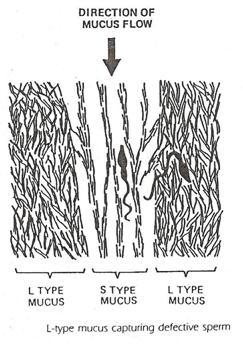L Mucus (oestrogenic)
L mucus (Fig. 11-12) is secreted during the whole fertile phase, in the L-secreting crypts which are distributed along the whole cervical canal, but dominating the lower half of the canal,4 and its production is stimulated by medium levels of oestrogen. When oestrogen begins to rise, the L cells begin to produce mucus. L mucus is the first oestrogenic type mucus to be secreted. L mucus is more fluid and begins to descend through the vagina and reach the vulva, initially dislodging the plug of G mucus which then flows to the vulva.1 This downflow is facilitated by the mucolytic activity of P2 mucus which is at its maximum level at the beginning of the fertile phase. When the L mucus exceeds 50% of the total mucus, the woman perceives the beginning of the fertile phase as a change in the character of the vaginal outflow.2 L mucus is sticky, a bit elastic and is either opaque or translucent.1 L mucus is responsible for the typical ferning pattern that has long been associated with cervical mucus.
 L-mucus has four functions:
L-mucus has four functions:
(a) The alkaline L-type mucus neutralizes the acidic vaginal secretions to provide a hospitable medium for sperm survival. Sperm die rapidly-perhaps within 30 minutes in the acid environment of the vagina in the infertile phase, but may survive up to five days in fertile-type mucus.2
(b) L mucus supplies a supportive framework for the S-mucus swimming lanes.3 Both L and S mucus co-operate to bring about optimal sperm propagation to a crypt.
(c) L mucus has a medium viscosity and it acts as a biological filter to weed out defective sperm.2
(d) L mucus closes the opening of the S crypts once they have been filled with approximately 20-30 spermatozoa.1
<< Fig. 11-12; Structure of L Mucus: Diagram of L mucus filtering defective sperm, and S mucus transporting sperm in the swimming lanes.
References:
- Klaus, H; ‘Natural family planning – Is it scientific? Is it effective?’ see page 4, 9, 10; Newman Lecture Series 1 -May 21, 2000. (online).
- Odeblad Erik; ‘Investigations on the physiological basis for fertility awareness; Bulletin for the Ovulation Method Research and Reference Centre of Australia, vol 29, no 1, p2-11, march 2002, (internet, Billings Ovulation Method, www.woomb.org )
- Odeblad, E; ‘The discovery of different types of cervical mucus and the Billings Ovulation Method’ page 10, 11,14, 15, 18 ; Bulletin of the Ovulation Method Research and Reference Centre of Australia, Vol 21, No3; 3-35; Sept 1994. (google ‘Erik Odeblad, cervical mucus’.)
- Menarguez M, Pastor LM, Odeblad, E. 2003; ‘Morphological characterization of different human cervical mucus types using light and scanning electron microscopy; Human Reproduction; Vol. 18 No 9, 1782-1789, Sept 2003; (google Erik Odeblad).


